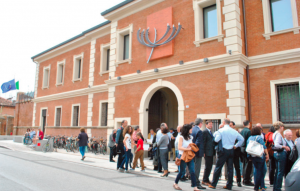FEATURES Ferrara, a Long Jewish History
Ferrara, a town in the Emilia-Romagna region of Northeast Italy, is known as being the melting pot for different Jewish cultures. Jews first emigrated to Ferrara hundreds of years ago since the local laws generally tended to treat Jewish residents with respect. Many of them had fled from areas that were controlled by oppressive rulers, and Ferrara was a place Jews could come to live relatively freely.
The Jewish community of Ferrara is one of the few in the Emilia-Romagna region, which has existed since the Middle Ages. In the 15th and 16th centuries, Ferrara was ruled by the family who encouraged the existence of the community. However, at the end of the 16th century, the Este dynasty was pushed to Modena, and the city came under direct papal control. The Pope did not favor the Jewish community, and in 1627 the Jews of Ferrara were forced into a few streets, which became the ghetto of Ferrara. The Jews of Ferrara remained in the ghetto for more than 200 years, until Italian unification in 1859.
With Unification came full rights and citizenship for Ferrara’s Jews for the first time.
Unfortunately, this period of openness and equality only lasted 78 years. In 1938, Mussolini’s fascist government enacted the racial laws which discriminated against Jews and created a kind of virtual ghetto, which lasted until the end of the German occupation in 1945. Under the German occupation, more than 180 Ferrarese Jews were rounded up by the Nazis and their Italian collaborators and deported to concentration and death camps. Very few survived.
Though rich in Jewish history, Italy had never had a National Jewish Museum… until now. Italy’s National Museum of Italian Judaism and the Shoah, also known as MEIS (Museo nazionale dell’Ebraismo Italiano e della Shoah), aspired to fill that void. After much debate, Ferrara was selected as the site of this new institution. This national museum would present the overarching sense of the history of Italy’s Jews; founders of the museum want visitors to “bear witness to the events that have characterized the two thousand years of Jewish presence in Italy,” and would be built in Ferrara. MEIS serves as a place of meeting and sharing in recounting the life experience of a consolidated minority.
Ferrara is an appropriate choice of location for such a museum since Ferrara hosts one of the oldest and culturally rich Jewish communities in the country. Prior to the National Museum, Ferrara did have a small local Jewish museum housed in the 15th century synagogue complex in the heart of the old Jewish quarter, but it has been closed to the public since Ferrara suffered earthquake damage in 2012.
It is an instance of poetic justice that the MEIS, which celebrates the culture of Italian Jews is housed in the old prison in via Piangipane – the very same prison in which Ferrara’s Jews were held by their Nazi-Fascist captors before being sent to the concentration camps, in an attempt to extinguish this great heritage. The first phase of the museum recently opened on December 13, 2017. Although the entire museum is not yet completed, the exhibit that opened on December 13th focuses particularly on the past history of Jews in Ferrara.
Originally, this museum was not established to address the complex legacy of Italian Jews. It was intended to be a national museum of the Shoah, when the idea was first conceived in 2003. But when Dario Disegni, the president of MEIS, joined the project in 2015, that original mission expanded so that the institution would become “the national museum of Jews.”
Disegni hopes that this museum will leave an everlasting impact on its visitors. He thinks that “the model represented by the Jewish community, which was a community that integrated in the society without abandoning and developing their identity, their cultural values, their religious values and so on, is a really good model to have in mind,” as he explained in an interview with The Forward. There are four more sections of MEIS to be built, which will be inspired by the five books of the Torah. They are expected to open by 2020.
*Aine Filler is a student at Muhlenberg College (Allentown, Pennsylvania, USA).

